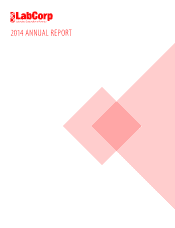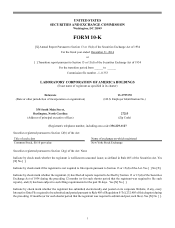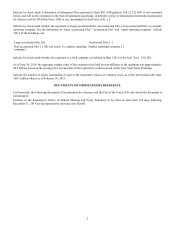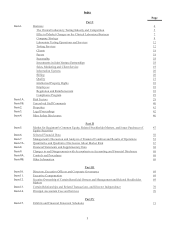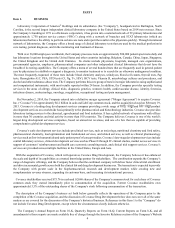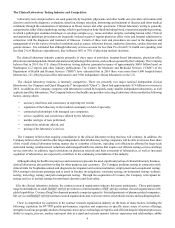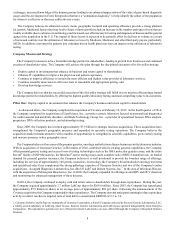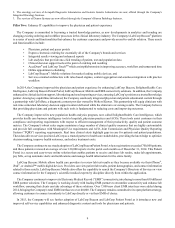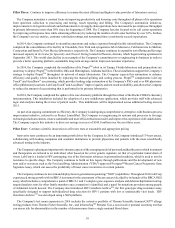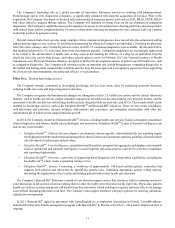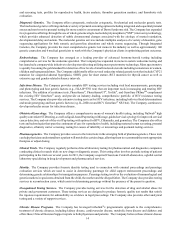LabCorp 2014 Annual Report Download - page 8
Download and view the complete annual report
Please find page 8 of the 2014 LabCorp annual report below. You can navigate through the pages in the report by either clicking on the pages listed below, or by using the keyword search tool below to find specific information within the annual report.
6
The Clinical Laboratory Testing Industry and Competition
Laboratory tests and procedures are used generally by hospitals, physicians and other health care providers and commercial
clients to assist in the diagnosis, evaluation, detection, therapy selection, monitoring and treatment of diseases and other medical
conditions through the examination of substances in blood, tissues and other specimens. Clinical laboratory testing is generally
categorized as either clinical pathology testing, which is performed on body fluids including blood, or anatomical pathology testing,
in which a pathologist examines histologic or cytologic samples (e.g., tissue and other samples, including human cells). Clinical
and anatomical pathology procedures are frequently ordered as part of regular physician office visits and hospital admissions in
connection with the diagnosis and treatment of illnesses. Certain of these tests and procedures are used in the diagnosis and
management of a wide variety of medical conditions such as cancer, infectious disease, endocrine disorders, cardiac disorders and
genetic disease. It is estimated that although laboratory services account for less than 3% of total U.S. health care spending (and
less than 2% of Medicare expenditures), they influence 60% to 70% of physician medical decisions.
The clinical laboratory industry consists primarily of three types of providers: hospital-based laboratories, physician-office
laboratories and independent clinical and anatomical pathology laboratories, such as those operated by the Company. The Company
believes that in 2014, the U.S. clinical laboratory testing industry generated revenues of approximately $60.0 billion based on
Washington G-2 reports and other industry publications. The Centers for Medicare and Medicaid Services (“CMS”) of the
Department of Health and Human Services ("HHS") have estimated that in 2014 there were more than 8,900 hospital-based
laboratories, 121,200 physician-office laboratories and 5,900 independent clinical laboratories in the U.S.
The clinical laboratory business is intensely competitive. There are presently two major national independent clinical
laboratories: the Company and Quest Diagnostics® Incorporated ("Quest"). Quest had approximately $7.4 billion in revenues in
2014. In addition, the Company competes with laboratories owned by hospitals, many smaller independent laboratories, as well
as physician office laboratories. The Company believes that health care providers selecting a laboratory often consider the following
factors, among others:
• accuracy, timeliness and consistency in reporting test results;
• reputation of the laboratory in the medical community or field of specialty;
• contractual relationships with managed care companies;
• service capability and convenience offered by the laboratory;
• number and type of tests performed;
• connectivity solutions offered; and
• pricing of the laboratory’s services.
The Company believes that ongoing consolidation in the clinical laboratory testing business will continue. In addition, the
Company believes that it and the other large independent clinical laboratory testing companies will be able to increase their share
of the overall clinical laboratory testing market due to a number of factors, including cost efficiencies afforded by large-scale
automated testing, reimbursement reductions and managed health care entities that require cost efficient testing services and large
service networks. In addition, legal restrictions on physician referrals and their ownership of laboratories, as well as increased
regulation of laboratories, are expected to contribute to the continuing consolidation of the industry.
Although testing for health care purposes and customers represents the most significant portion of clinical laboratory business,
clinical laboratories also perform testing for other purposes and customers. The Company performs testing in connection with
clinical trials for biopharmaceutical and diagnostic development and commercialization; employment and occupational testing;
DNA testing to determine parentage and to assist in forensic investigations; veterinary testing; environmental testing; wellness
testing; toxicology testing; and pain management testing. Through the acquisition of Covance, the Company will expand its
testing services to include testing for nutritional chemistry and food safety.
Like the clinical laboratory industry, the contract research organization industry has many participants. These participants
range from hundreds of small, providers to a limited number of contract research organizations with
global capabilities. Covance Drug Development primarily competes against departments of pharmaceutical companies,
full-service and contract research organizations and, to a lesser extent, selected universities and teaching hospitals.
There is competition for customers in the contract research organization industry on the basis of many factors, including the
following: reputation for quality performance; expertise and experience in specific areas; scope of service offerings;
strengths in various geographic markets; therapeutic areas; price; technological expertise and efficient drug development processes;
ability to acquire, process, analyze and report data in a rapid and accurate manner; historic experience and relationships; ability

